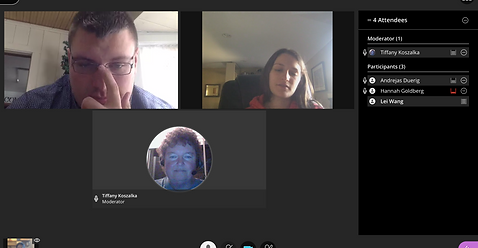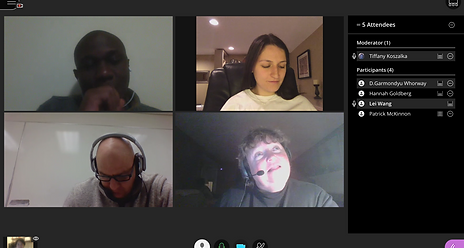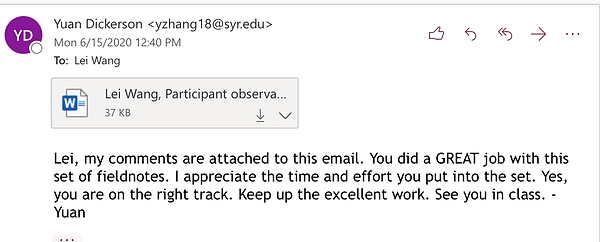

Lei Wang
Oceanography Research Assistant
Blue Cove University, Department of Earth & Environmental Sciences
500 Terry Francois Street San Francisco, CA 94158
Phone: 123-456-7890
Email: info@mysite.com
Doctoral Coursework Overview \
My doctoral coursework has helped me establish a solid foundation for my research.
Courses Taken from Fall 2019 to Fall 2020
Fall 2019
EDU 647 Statistical Thinking & Application
IDE 841 Design of Inquiry
IST 617 Motivational Aspects/Info Use
Spring 2020
IDE 756 Design of Online Courses
EDU 655 Educational Test & Measurements
IDE 742 Intro to Survey Research
IDE 990 Independent Study
Summer 2020
IDE 603 Intro to Qualitative Research
Fall 2020
IDE 800 Observational Research
APM 630 Regression
Analysis
APM 645 Nonparametric
Statistics and Categorical
Data Analysis
IDD&E DEPTH COURSES
IDE 756 Design of Online Courses
Grade: A
Summary: In this course, I first studied online instructor and learner competencies and created guidelines for interactivity and digital resources used in online courses. I then explored various topics relating to designing online instruction, designed storyboards and critiqued other teams' instruction. The emphasis of this course was on experiencing and reflecting on online teaching and learning strategies and technologies used in the design and delivery of online instruction, designing purposive online instruction, and developing competencies to plan, design, implement, and evaluate online instruction.
Reflections: I probably won't forget the experience of taking this course. I spent several days in the library and finished reading books related to online teaching and the ibspti online learner competencies. I differentiated different terminologies related to online learning and teaching. I like the way Dr. Koszalka participated in our online discussion. She guided us in an in-depth discussion and corrected misleading answers. I took this course in Winterlude, when almost all Americans celebrate the holidays with their families. I gained new experience by working with 2 American non-instructional designers. I drafted the learning objectives first and then broke them down into a single step or a chain of steps to complete and invited them to have a meeting together. We were very productive in the kick-off meeting and designed the process to organize instructional materials and identified all the tasks that need to be done in detail. We set our deadlines, and I was expecting to complete the tasks with them on time. However, I couldn't receive any updates. As we approached the deadline, I was worried and completed all the storyboards. I worked very hard on every detail of the storyboards, and received positive feedback from my professor. One of our teammates later actively participated in critiquing the other team's work. We worked very well. This was my first experience working with an undergraduate student on a graduate course. I didn't know much or prepare well for contingencies, but I believe I can do better next time.
Development in IDD&E: For this course, I read about ibspti online learner competencies and instructor competencies, which can prepare me to be competent in designing online courses, whether they are synchronous or asynchronous. I equipped myself with a variety of resources and strategies to solve instructional problems. My experience in and reflections on online teaching and learning strategies and technologies used in the design and delivery of online instruction helped me build a solid foundation on the design of online courses and identify strengths and weaknesses of different designs.
Artifacts: A) final group project; B) final group critique;

Screenshot from the first small group meeting on December 9,2019 via Blackboard Collaborate Ultra.

Screenshot from the last synchronous meeting on January 5,2019 via Blackboard Collaborate Ultra.
IST 617 Motivational Aspects/Info Use
Grade: A
Summary: This course focuses on creating a motivating environment within an organization, whether it is a library, a small business, a corporation, a government agency, a start-up, or a school. The motivational principles studied in this course can be applied to all of our own disciplines. This course was eye-opening. Through readings, online discussions, videos, and class activities and assignments, I learned traditional and innovative applications of motivation theories and models and came to better understand how to improve learning, work, and virtual environments.
Reflections: I am very grateful to Garmondyu, who introduced me to this course. I still clearly remember how thrilled I was reading the syllabus for this course one night at 2 AM. I read the syllabus several times. I couldn't wait for the first class. I sent Dr. Arnone, the instructor, an email to express my gratitude for such an exciting course even before the course began. The course was magical for me. I found that the theories and models we had studied previously could be applied to all aspects of this course, such as conversations, choice of assignments, opportunities to work alone and in groups, and discussions about the challenges we faced as information professionals. The readings were not as numerous as I imagined they would be before I took the course. However, there were many questions that prompted me to think in new ways. The instructor set different levels of assignments for different levels of students. We could move progressively through the levels to push our understanding deeper—making my studying more meaningful and improving my long-term retention. I could always finish the work without external rewards. I actively and spontaneously became involved in activities and found the process of learning enjoyable.
I was also inspired by this professor, Dr. Arnone. She worked so hard when she taught us. She had 18 students in our section alone - and 3 different sections simultaneously. I can't imagine how she managed it all. She replied to all the questions on the Discussion Board and email, graded assignments, scheduled 1:1 Zoom meetings, gave us long, meaningful, and constructive feedback promptly. I felt like she cared about students so much and she was passionate about her students’ success. She went above and beyond in everything she did: the way she taught, the homework assignments and discussion board she made, the office hours she held, and every minute she spent with her students. She was never annoyed when we asked questions, but instead always responded with "What a great question" on the Discussion Board and answered it to the best of her ability. She also always use encouraging words to share her experience and motivate me to move forward. We still keep in touch by email even after the course ended.
Development in IDD&E: Motivational theories such as self-determination theory and the ARCS model are relevant to the learning domain. Motivation can be considered a prerequisite to learning. It represents the integration of learning. The theories of motivation have also yielded important implications for the instructional design process. In particular, Keller’s ARCS model specifies how to take learner motivation into account when designing instruction. Expanding upon Keller’s work, I am devising many technologies to boost learner motivation. Moreover, the motivational theories help me identify effective techniques for enhancing instructional design, improving classroom management, and meeting the needs of diverse student population, which all contribute to enhancing the teaching-learning environment.
Artifacts: A) instructor's comments on Assignment 1; B) instructor’s comments on Assignment 2 ; C) instructor's feedback on my self-evaluation; D) presentation on Self-efficacy theory;
IDE 990 Advanced seminar in design and development
Grade: A
Summary: This course was a specialized doctoral seminar that provided me with a forum to explore and understand the history of the instructional design field, the variety of design and development theories and models, the trends of selected top journals and research topics in the area of instructional design. It helped me identify and develop my own research interests' fit in our field.
Reflections: We started this course with plenty of pre-work. We were supposed to review journal articles and determine the trends of different issues of 4 top journals. When class began, we discussed the trends of different journals and how our research interest fitted in our IDDE field. We also worked in teams to complete two different projects. I worked on a project management work plan with the ADDIE process as a framework. Even after considerable effort, the project was not accepted, and we had to redo it according to the professor’s feedback to develop a generic management plan. The change stimulated my interest because I had never thought of or seen a generic management plan before. How did she think of such an innovative idea? I started to develop my research by thinking, reading and redoing. This cycle became the theme for our course, guiding me throughout the entire learning experience. The strenuous work finally paid off. This course opened the door for me to conduct research and helped me develop a habit of reading journals.
Development in IDD&E: As per the course design, I plunged into the scholarly literature and gained insights that led to discovering where my interests fit within the research world of instructional design. What appeared to begin as uncertainty ended with illumination and a sense of direction about what I can do to contribute to the field.
Artifact: A) Group Projects ; B) Reflective summary of this course; C) Compiled Journal review and reflections; D) Summary of our group project and critique of the other group's project; E) Tutorial notes and reflections; F)The historical research on self-regulated learning
The course created an intense atmosphere and helped me develop a deeper level of critical thinking and articulate critical thoughts in written and verbal forms.
Research Courses
IDE 841 Design of inquiry
Grade: A
Summary: In this course, Dr. Moon-Heum Cho introduced the basic skills, processes, and designs of empirical inquiry, in particular three types of design, including experimental design, cross-sectional design, and case studies. The highlight of this course for me was that Dr. Cho brought me, a novice researcher, into the increasingly diverse disciplines and subdisciplines of educational research. Within his well-structured design, we practiced what we learned, tested our understanding, and received feedback promptly to guide the learning process and eventually ensure our mastery of key learning outcomes. He also invited some prestigious professors to our class so that we could learn from their experience and guided practice in conducting research. We were also offered one research article to discuss in class, and gradually we developed our abilities to make some key decisions with regard to research design and an in-depth understanding of the multiple research designs and procedures that we can use in our studies.
Reflections: This was the first research course I took as I started my Ph. D. program. At first I thought I was not ready for the course. Dr. Cho provided me with a complete picture of the general nature of educational research and the specific qualitative and quantitative research approaches. He first demonstrated how to critique a peered-review article. We then started to critique a paper, which allowed me to strengthen my own final paper in the course. I also appreciated the suggestions he gave me on my career and my research topic based on my previous educational background.
Development in IDD&E: I was introduced to educational research and research design. This course made me aware of how to use scientific methods to avoid producing inaccurate information. Research designs we learned in class have been used as a blueprint or a plan for my action in conducting research in IDD&E, specifying the methods and procedures for collecting and analyzing the needed information, fulfilling research objectives, and finding solutions.
Artifacts: A) Final design report; B) Final paper peers' critique; C) Feedback from Dr. Cho
EDU 603 Introduction to qualitative research
Grade: A
Summary: This course helped students review the foundations of qualitative design, investigate the history, philosophy, and nature of qualitative research. Examples of different types of qualitative research were discussed. In addition to in-class discussions, students had the precious opportunity to develop their own projects and conduct a pilot study. Through this preliminary process, students gained direct experience with the practice of qualitative research, including developing an interpretive qualitative research question, crafting a research design, establishing a conceptual framework, engaging in data collection and analysis techniques, and learning some of the conventions of writing up research.
Reflections: I felt lucky I was guided by my advisor Dr. Koszalka to take an intro qual course before taking the advanced qualitative courses with her. I took this course over the summer, and the instructor gave me the autonomy to choose my own project. I was also allowed to continue my previous project, which integrated qualitative and quantitative methods. I continued the other half of my project, In-Service Middle School English Teachers’ Beliefs, Knowledge, and Practices in Developing Self-Regulated Learners in China. This had been my research interest for a long time. I appreciated how the instructor guided us to understand how qualitative researchers produce knowledge and the possibilities and limitations of qualitative inquiry. The course challenged me because we had many assignments and in-class presentations. I had to finish the readings first and then used my own words to interpret the essential concepts and techniques and interpretive research questions in class.
Development in IDD&E: I enhanced the study that I conducted in IDE 742 Intro to Survey Design. Taking the course made me think about the primary characteristics that should be considered during the design process of that study. After that quantitative study, I realized I need to interview some in-service teachers because I still couldn't illustrate some findings. Taking EDU 603 helped me solve this problem. After taking that course, I realized my study should be a quantitatively driven, mixed-methods research, replying on a quantitative, postpositivist view of the research process, while concurrently recognizing that the addition of qualitative data and approaches are likely to hone the study.
Artifacts: A) Final research proposal with instructor's feedback; B) Research proposal; C) Presentation on ethnography with a classmate ; D) Reflective summary of 3 qualitative studies; E) Presentation on an ethnographic book; F) Participant observation #1; G) Course syllabus Summer 2020 EDU 603 H) Interview protocol; I) Field Series Notebook Data Collection & Memos

Screenshot of instructor's comments on my assignment on June 15,2020 via a e-mail
EDU 647 Statistical thinking and applications
Grade: A
Summary: This course helps graduate students, especially doctoral students, learn basic statistical concepts and operations in the quantitative research tradition. A number of foundational issues have been addressed, including science and causality; constructs, variables, and research questions; measurement concepts; research design and research validity; descriptive statistics; and inferential statistics. An integrated approach was used to help students understand the interrelationships of theory, research design, measurement, and statistics in the context of planning, accomplishing, and evaluating quantitative research articles.
Reflections: The course is obviously important and relevant to my research. I was thrilled to take this course in the beginning. I had never taken a statistics class before, so I was not sure what to expect, but I believed I could do it well because the instructor was bilingual and we speak the same language. In the beginning, it was not too hard, but later I found it had a lot of math involved in it, but I never took any math classes after high school. I spent numerous nights watching related videos and reading some related books. With the instructor's help and great effort, I could use R-studio to do the calculation and interpret my results of the statistical tests. I understood basic measurement concepts, including reliability and validity of assessment instruments, and their relationship to research validity and statistical outcomes by taking quizzes. I think the quizzes were really helpful to measure how much I have gained from this course. I had a working knowledge of basic research (e.g., latent variables, operational definitions) , statistical concepts (e.g., variance, effect size), that are central to quantitative research methods, descriptive statistics, including measures of central tendency, variability, and relationships, inferential statistical concepts including probability and statistical significance testing, and understand their role in social science and various basic statistical strategies that are used to analyze data and when to use each type, including t-tests, analysis of variance, chi-square, correlation, and multiple regression.
Development in IDD&E: The course helped me grow as a researcher who uses statistics. I can differentiate various experimental and non-experimental research designs and their strengths and limitations in regard to research validity. It's vital for me to conduct a study on a new instrument in terms of validity and reliability. By evaluating published research, I routinely apply simple but critical statistical methods to understand and search for patterns in the data. Such procedures are paramount in identifying interviewer-level and project-level issues that can be addressed to improve the quality of the data while doing research related in our field.
Artifacts: A) Final paper ; B) Critique 1; C) Critique 2; D) Course syllabus 2019 EDU 647
EDU 655 Educational Tests and Measurement
Grade: A
Summary: This course was unique. All the learning resources, discussions, and different types of tests were kept on a Google Site, and all the sources were meticulously selected. The layout of the website is clear and easy to follow. The course has provided me with the ability to practically conceptualize, develop, design, and implement an integrated assessment, instruction, and management system for enhancing any learners’ proficiency in an educational domain. The course applied a variety of strategies in designing and delivering education. The course began by providing a basic knowledge base and competence in the area of statistics. Practical applications of interpreting and representing data in terms of central tendency, variation, and distribution were put into practice and discussed.
Reflections: I like this course very much. The instructor was humorous, approachable, enthusiastic, and caring. Whenever I had questions about the assignments, he would schedule a 1:1 Zoom meeting with me, provide me with additional resources, and share with me his personal experience. I learned how to use grade book to motivate my students in IDE401, which I had a lot of fun doing. I also learn many slang expressions and communication skills from the instructor. The course was not easy for me, but with his encouragement, I made great progress in each assignment. I still remember I got 29/40 for the first unit test. At that time, I was not satisfied with my score and talked with my instructor. He gave me some suggestions on reading the MAE book and understanding the purpose of the quizzes. I spent lots of time on this course, and luckily the effort paid off eventually.
Development in IDD&E: By examining the different types of definitions used in tests and measurement, I differentiated descriptive and operational definitions in reference to assessing a performance domain. Taking this course made me realize one serious problem in my research study. I had been trying to provide a measurable OPERATIONAL definition of the phenomenon from my instrument agenda: the cyclic model of self-regulated learning. It was so hard. I reviewed the related research articles to support my operational definition and determined the domain and type of instrument to measure my phenomenon as defined. To my surprise, all the descriptions were vague and hard to measure. This made me think of my research study, the rubric to evaluate learning resources. I went through the items one by one, trying to make sure all the instructional designers who use test and measurement results can set and implement instructional agendas. The various design criteria that have been used in this course also helped me define “effective testing and measurement practices.” In addition to validity and reliability, consideration is given to the four other design criteria, including: comparability, interpretability, relevance (or authenticity) and completeness. The conceptualization and application of tests and measurement lit up my enthusiasm and gave me direction in doing research on a new instrument.
Artifacts: A) Final project—Assessment instrument with instructor’s comments; B) Weekly learning reflections; C) Post-test 3 performance; D) Course syllabus EDU 655
IDE 742 Introduction to survey research
Grade: A
